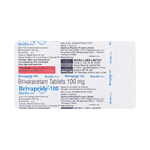briv
Introduction to briv
Briv, also known as Brivaracetam, is a medication primarily used to treat seizures. It belongs to a class of drugs called anticonvulsants, which help control abnormal electrical activity in the brain.
Composition of briv
Briv contains the active ingredient Brivaracetam, which works by targeting a specific protein in the brain to help manage seizures.
Uses of briv
- Treatment of partial-onset seizures in individuals with epilepsy.
- Can be used as part of a combination therapy with other seizure medications.
Side effects of briv
Common side effects:
- Drowsiness
- Dizziness
- Mood changes
- Nausea and vomiting
Serious side effects:
- Suicidal thoughts
- Changes in behavior
Precautions of briv
Briv may cause cognitive side effects like difficulty concentrating or confusion. If you feel depressed, notice mood changes, or have thoughts of suicide, inform your doctor immediately. Do not stop taking it suddenly, and avoid driving or operating heavy machinery until you know how it affects you.
How to Take briv
- Can be taken orally as tablets or liquid, or via injection.
- Adults typically take 100mg a day, but the dosage can range from 50mg to 200mg.
- For children, the dosage depends on their weight.
Conclusion of briv
Briv is an effective medication for managing partial-onset seizures in epilepsy. While it offers significant benefits, it's important to be aware of potential side effects and take necessary precautions. Always follow your doctor's instructions for dosage and administration.
Similar Medicines
Available in 4 variations

Briv + 50mg Tablet 10s
strip of 10 tablets

Briv 25mg Tablet
strip of 10 tablets

Briv 50mg injection
vial of 1 injection

Briv 100mg Tablet 10s
strip of 10 tablets
Related Faqs

Can Dixval damage my liver?
Dixval has the potential to cause harm to the liver particularly within the initial 6 months of commencing treatment Adverse effects on the liver can manifest as symptoms such as loss of appetite nausea or vomiting stomach pain darkened urine facial swelling or the yellowing of the skin or the whites of the eyes Hence it is crucial to undergo liver function tests before initiating the medication and to continue conducting these tests on a regular basis throughout the first 6 months of therapy This precautionary measure is especially vital for individuals who are deemed to be at a higher risk as well as those who have a previous history of liver disease By closely monitoring liver function healthcare providers can promptly identify any signs of liver injury and take appropriate actions to mitigate potential harm It is of utmost importance to prioritize the health and wellbeing of patients and by implementing these precautionary measures the risks associated with Dixval can be minimized

How long does it take Lambi to work?
The duration of symptom improvement can vary from individual to individual but generally it may take approximately 6 to 8 weeks for your symptoms to start getting better This timeframe allows for the body to adjust and respond to the treatment or natural healing process It is important to note that the healing process is unique to each persons circumstances and condition so the rate of improvement may differ However with time and appropriate care you can expect to experience a gradual alleviation of your symptoms Patience and adherence to the recommended treatment plan are crucial during this period as it allows for the body to fully recover and regain its optimal functionality Additionally it is advisable to consult with your healthcare professional or specialist to monitor your progress and make any necessary adjustments to your treatment plan Remember the healing journey may take time but with patience and diligence you can expect to see positive changes in your condition

On stopping Cloneepam what kind of withdrawal symptoms occur?
Abruptly discontinuing or rapidly reducing the dose of Cloneepam can give rise to a range of common symptoms These may encompass challenges with falling asleep shifts in mood and heightened perspiration Additionally individuals may experience muscle discomfort headaches trembling or restlessness and an overwhelming sense of anxiety tension confusion irritability or agitation When Cloneepam is suddenly halted or its dosage is reduced too swiftly the body may respond with these noticeable manifestations It is crucial to be aware of these potential effects in order to ensure a smooth transition and to prevent any unnecessary discomfort By gradually tapering off the medication under the guidance of a healthcare professional these unpleasant symptoms can be minimized allowing for a more manageable adjustment period It is important to prioritize ones wellbeing when deciding to discontinue or reduce the dose of Cloneepam Seeking professional advice adhering to a tapering plan and closely monitoring any emerging symptoms can contribute to a successful transition minimizing any potential disruption to daily life Remember a cautious and gradual approach is key to navigating this process with minimal discomfort

Are there any serious side effects associated with the use of Gabtan AT?
Serious side effects with Gabtan AT are uncommon and rare. Tell your doctor as soon as possible if you notice changes in body temperature, difficulty in breathing, increased heartbeat (palpitations), weakness, unsteadiness when walking, reduced coordination or slowed reactions, unusual changes in mood or behavior such as restlessness, nervousness or excitement, signs of depression, seeing or hearing things that are not there, irrational thinking, blurred or double vision, uncontrollable jerky eye movements, difficulty seeing, signs of frequent infections such as fever, severe chills, sore throat or mouth ulcers. These side effects are uncommon but may be serious and may need urgent medical attention.

Are there any serious side effects associated with the use of Gabtan AT?
Serious side effects with Gabtan AT are uncommon and rare. Tell your doctor as soon as possible if you notice changes in body temperature, difficulty in breathing, increased heartbeat (palpitations), weakness, unsteadiness when walking, reduced coordination or slowed reactions, unusual changes in mood or behavior such as restlessness, nervousness or excitement, signs of depression, seeing or hearing things that are not there, irrational thinking, blurred or double vision, uncontrollable jerky eye movements, difficulty seeing, signs of frequent infections such as fever, severe chills, sore throat or mouth ulcers. These side effects are uncommon but may be serious and may need urgent medical attention.
Related Posts

1:15
Are Your Hormones Out Of Balance? Signs & Symptoms!

1:15
How Do You Know If You Have a Vaginal Infection? Warning Signs!

1:15
Top Health Benefits of Cinnamon | How to Use It for Better Health!

1:15
Is Your Blood Pressure Too Low? What Are the Best Remedies to Fix Low Blood Pressure Instantly?

1:15
Mala D: How it works, When and How to take Mala D and Side Effects of Mala D!






















.svg)
